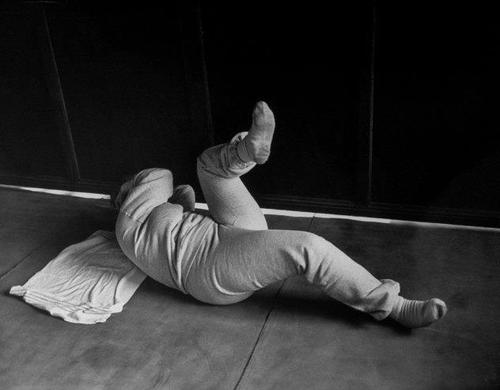Notes on a talk by Michael Stone at Centre of Gravity, April 21, 2013
Not Me
During sitting practice, when something arises you become intimate with it, without identifying with it. Without making it part of me and mine. In mindfulness practice it’s helpful to discern the difference between a sensitivity to present experience, and a hypervigilance that turns into a paralyzing self-consciousness. How to allow experience to flow through the open field of awareness without grasping?
This is the final talk about Shantideva’s A Guide to the Bodhisattva’s Way of Life, and we were going to cover chapter nine today, only chapter nine is impossible. You have to know so much about Indian philosophy to get through a single page. The previous eight chapters has an author speaking passionately and with clarity and then chapter nine arrives, I’m doubtful Shantideva had anything to do with it.
In his commentary (called Flash of Lightning) on the text, the Dalai Lama says that the reson for putting wisdom at the end and teaching emptiness in the last chapters, is that first you need the relative. First generosity and ethics and care for others. And then the first step in looking at emptiness is looking at the inherently existing I. Finding it as it appears. Then we see how it’s falsely conceived. Emptiness is a way of seeing/finding the non-absoluteness of things.
Schools
There are two main wings in Buddhist practice: emptiness and compassion. They rely on each other, they’re synonymous. When they work together that’s what the Buddhist tradition calls wisdom. The last chapter offers an analysis of emptiness, compassion, mindfulness and the self. Different schools are pitted against each other. The first school of ordinary people (have you met them?) features people who think their lives are real, they meet and sometimes get married and have children or don’t, and then they die. The second school is the abhidarma school. They know that humans are made of the five skandhas and that everything changes. With a little meditation we can experience ourselves as empty and interdependent. The third school is the Chittamatrins school that says yes, we’re made of changing components in conditions but these aren’t real either. Only the mind is real, everything is a representation. The fourth school is the Madhyamika school which is emptiness par excellence. Mind and consciousness are also empty.
Types
Perhaps instead of different schools we can look at four types of personalities: borderline, schitzophrenic, depressive, narcissist. I raise the specter of types under quotation marks not least because practice began for me via my uncle who lived at the mental health hospital. I wanted to be either a monk or a psychologist, but when I started studying psychology I became so angry, and felt that they were drug salespeople. Let’s use categories, and then put them away, they are only tools. They have been used to hurt people in deeply exploitative ways.
My Bus
It’s important to distinguish between self consciousness and mindfulness. Are you paying attention to your feelings? Yes. Are you paying attention but within the frame of the self? As the practice of mindfulness mature you gain the ability to see how experiences are not fixed, how views are not fixed. What you thought was permanent and stable turns out to be unstable. As your practice has more quiet and stability you can see deeper layers of how your psychology is organized. The self you think exists doesn’t have a bottom. Though the personality is designed so that the bottom doesn’t drop out. Buddhists see that the mind turns in order to construct an “I” – to turn it into a thing. Psychology has a very similar view, they say we have an unconscious ego ideal we’re building all the time. At the centre of the personality, the ego ideal draws attention towards it, experience feeds into the ego ideal. We carry around a representation of ourselves, and it’s a good thing because it helps to organize the many versions of yourself. We’ve all had the feeling of losing ourselves, this means being unable to return to this matrix of self that is the ego ideal, and this is what starts to dissolve during meditation. The problem with the ego ideal is that it constantly distorts the way we experience reality. It turns the wait for the bus into my wait for the bus. The bus becomes my bus. The driver becomes my angry driver. The world has this fundamental perceptual warp in it, as if it’s been designed so that I can experience it. It’s a kind of madness, but this is what the mind is constructed to do. Buddhism teaches the groundlessness of every perception. Sensations and perceptions arise in conditions but they don’t have solid ground.
McMeditation
The practice of Buddhism has emptiness as its realization. That’s why the Dalai Lama says: When your mind gets still you want to fall asleep because you mind doesn’t recognize your mind. What is this myself? It can make you tired. When we enter deep states of meditation there is a re-organizing of personality, and that can be dangerous. Willoughby Britain is a neuroscientist who has been doing research about the effects of sitting practice. She presented her research to the Dalai Lama, and talked about the dark places people can wind up in during deep retreats. Shortly afterwards, the Dalai Lama was asked to give a blessing to a temple. When he arrived he saw there was no library. Why is there no library? I can’t give a blessing if there’s no library he told them. In other words: you need the old maps of practice, of what can happen with a mind in that silence, and we can bring that together with western structures like psychology and different personality structures. Otherwise we get McMeditation, a one size fits all program.
Borderline Personality
Most lacking is the ability to synthesize multiple self representations. The ego ideal has to consolidate all the variations, the different selves that you are. But with the borderline personality the ego ideal gets stuck, fixed on one of the split-off versions. The ideal ego gets fused with split version of self-representations. There’s no ability to take a healthy distance, to feel the division between me/not me. Meditation practice can be so helpful for borderline personality disorder because it strengthens the ability to synthesize different energies, to allow different selves to arise without identifying with them. To see different parts of the self without splitting or clinging. But if their practice focuses on emptiness, they could lose these split off parts. Someone who has shaky personality constructs can drop acid and see the emptiness in everything, how at the core of any structure there’s nothing at all, but then trouble could arise. Destructive urges can take over, or de-personalization and lack of energy. Nowhere in the literature do we talk about getting rid of the ego. The ego is sacred. It’s a good thing. But it’s not absolute, it’s not a God.
Narcissism
Narcissists tend to be grandiose in a pathological way. Some wind up as celebrity yoga teachers in the United States. They project negative versions of themselves onto other people. They don’t own their own negativity or aggression, they only see it in others. This split can only be soothed by being admired, though this is not a real cure. They like to surround themselves with people who admire them. When narcissists sense a change in sitting practice the result is arrogance. They can be hard to work with because they’re so valued in our culture. So many leaders in our culture suffer from this problem but are too busy being rewarded for us to notice.
Schizoid
Feels emptiness as an innate quality, and these deep feelings create a separation from other people who don’t feel it. Hypersensitive and easily overstimulated, as babies they shrunk from sensation because they were flooded with it. Nerves are close to the surface. They are preoccupied with avoiding being engulfed, taken over, eaten up, absorbed. They’re always saying: come closer, stay away. They’re always trying to preserve their safety. The way they are in touch with inner sensibilities can awe their friends, how very deep you are, they perceive what others disown. But they can lack compassion for those less lucid, with less feeling than they have. And this can create alienation. Love, hatred, tenderness, longing, mourning are unavailable. They don’t feel anxious, they feel disintegrated. There’s new research now about diet and schizoid personality. The focus is on strengthening internal boundaries, particularly in the small intestine by eliminating gluten and eating bone broth. The schizoid personality gravitates towards the path of maximum resistance, they go after boundaries. They can transgress rules/borders of society, violating religious sanctions or family structures. The benefits of meditation: how to trust yourself, how to build boundaries within yourself. The danger of meditation for schizoid is believing no one has feeling or that things don’t really exist. The kids that are sent to see me by their parents are invariably labeled as schizophrenic. I tell them there’s a part of their experience they can trust, it’s your breath. Your breath is your best friend. It will never leave you, and when it does, you don’t have to worry about it. Benefit of meditation practice: to cultivate security. This happens in inner life and relationships. As they learn to trust themselves, a close relation to a meditation teacher who can create a larger container can be so helpful.
Depression
Emptiness or their experience of emptiness is beyond loneliness, a deep internal void. There’s nothing inside. This can dovetail with a sense of deep worthlessness. Lack of energy, sadness, inability to enjoy pleasure, not eating or sleeping. Freud was the first to compare depression with mourning. While mourning, the external world is diminished, there’s less of it, someone is missing. In depressive conditions what feels lost or damaged is part of oneself. In a sense it’s the opposite of grieving. There is a deep sense of hatred. Sadism. Instead of feeling anger they feel guilt because it’s always their fault. “When accused of a crime I didn’t commit I wonder why I’d forgotten it.” They are usually excellent friends, generous, sensitive, compassionate, quick to give others the benefit of the doubt. Their meditative practice is to contact the good, which means Buddha nature. At bottom, you’re really good. We’re in a culture that favours the negative, it’s so easy for every one of us to go down the old roads of thinking negatively. Meditation works against this. Meditation can open the sitter to a broader range of feelings. You know depression is moving if there is more feeling. Depressives don’t really feel anything. In place of feeling there is rumination. What’s helpful is contact with the body, bringing the energy of rumination into the body.
We need to learn to better understand how to help serious meditators when they get stuck with their incompleteness.
Harbour
The goal of meditation is to examine the fundamental misperception that there is a self. And this requires long term practice. I think we’re all prone to ignoring how the self is falsely constructed. We can tend to rest in the tranquil states, instead of using a newly gained calmness to look around. Meditation offers us a safe harbor because it reduces stress, but it can be easy to hang out in the harbor, instead of using it as a base to explore our lives. When we recognize the way our perceptions are constructed, when we see the wiring, we see how it influences our lives.
When we recognize our misconceptions we weaken their influence.
Kwan Po: People are afraid to forget their minds. They fear they will fall through the void with nothing to stop their fall. They do not know that the void is not really the void, but the realm of the real dharma.
Mind Can’t See Mind
Seeing awareness is like the hand trying to touch the elbow. It’s like trying to touch your fingernail with your fingernail. Shantideva: “Mind cannot see mind. Just as the edge of a sword cannot cut itself, So (it is with) the mind.”
The primary task of the meditator in the first years is to suspend habitual ego functions. That’s why we focused on the difference between self consciousness and mindfulness earlier.
How can we note what’s going on without criticism. Look at what’s going on and feel it. Adapt. Sooth. When the discursive mind is settled, there is peace. But emptiness is something else. It’s using that space to investigate. Most longer term meditators I meet have been dissociating themselves from what they see as unwholesome. The result is submission to practice or to groups. Mindfulness is the capacity to surrender to the moment in whatever form it arrives in. It’s not about throwing anything away.
Lacan: The infant assumes an image creating a mental permanence of ‘I,’ this form situates the agency of the ego in a fictional direction… creating the illusion of autonomy.” We want to see the image of the self as just that, an image. The key to long term practice is to see the fiction of the ego. And not to let habitual modes of thinking get in the way of seeing. But how to do it while being supported? Mostly people disassociate parts of themselves, compartmentalize, deeming some part not wholesome. Sometimes we need to be pushed, sometimes we need to relax so we can find the balance between emptiness and compassion. With these two wings we can go very far.
The key to long term practice is to see the fiction of the ego. But how to do it while being supported? Mostly people disassociate parts of themselves, compartmentalize, deeming some part not wholesome. Sometimes we need to be pushed, sometimes we need to relax so we can find the balance between emptiness and compassion. With these two wings we can go very far.






